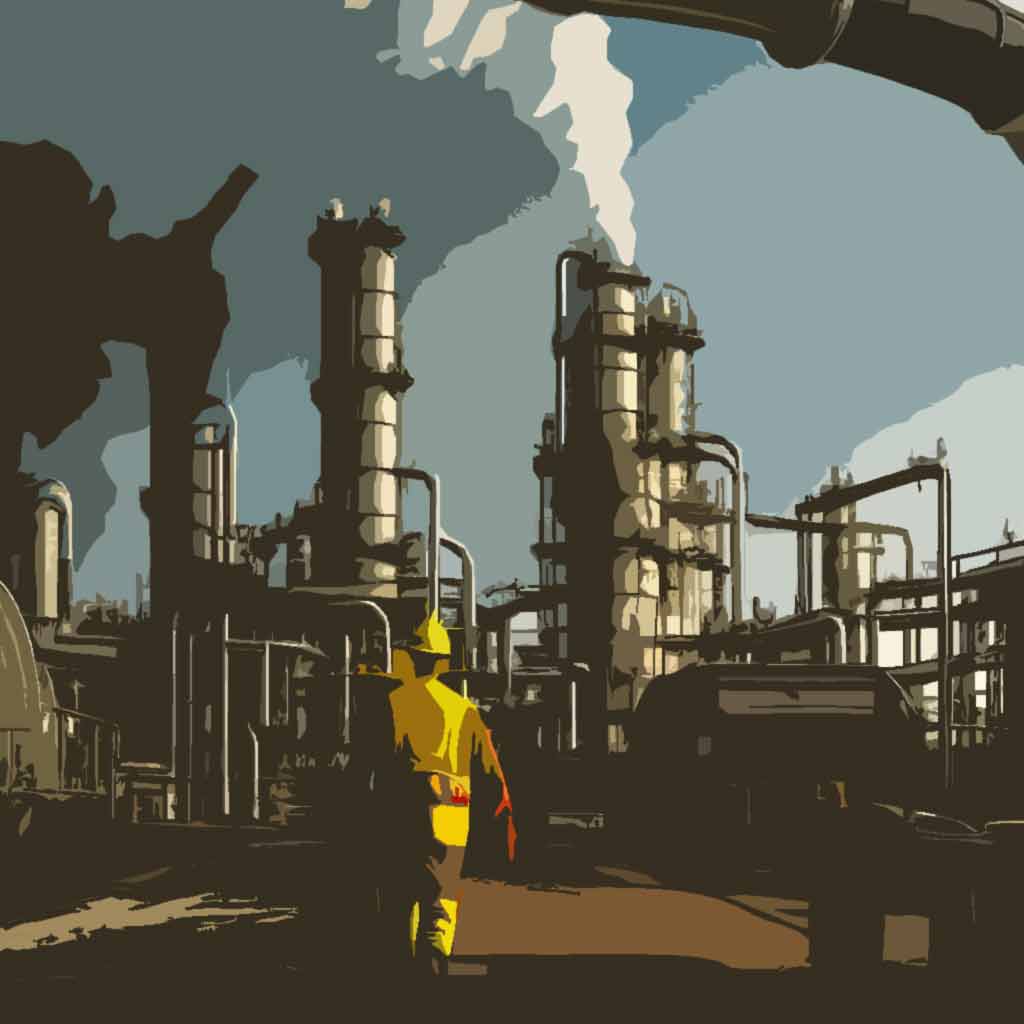Unlocking the Mystery: What Really Defines a Confined Space?
What is a Confined Space?
What is a confined space? Well, that depends on where you work. There is yet to be an internationally accepted definition of what is considered a confined space.
Each province has their own idea of what defines confined space. The Canadian Standards Association (CSA) also have their own. I have listed all the confined space definitions by Jurisdiction below.
Regardless of where you work, it is essential to train supervisors and workers on confined space safety procedures continuously. Part of this training includes WHMIS training and Heat Stroke Prevention.

There are many similarities but also several differences between the definitions of confined space in each of the Canadian provinces and the United States:
Similarities in the Confined Space Definitions Across Canada
Confined spaces are generally defined as enclosed or partially enclosed spaces, not designed for continuous human occupancy, with limited entry and exit points.
Differences in What Is Considered a Confined Space:
Some jurisdictions specifically exclude mining operations. For example, British Columbia and New Brunswick.
Some jurisdictions include a list of examples of confined spaces. For example, CSA, PEI and the USA.
The CSA definition includes an ‘internal configuration that can complicate first aid, evacuation, rescue, or other emergency response services’ and the note that that all confined spaces are considered hazardous unless a competent person has determined otherwise through risk assessment.
Some jurisdictions require that the confined space must be large enough and configured so that a worker could enter. For example, British Columbia, Yukon and the USA
The more recent Canadian definitions (Canadian Federal Regulation and the Saskatchewan definition) include two definitions, “confined space” and “hazardous confined space.” Similarly, in the US, there are two definitions, non-permit confined space and permit-required confined space.
Splitting the types of confined spaces into these two categories is well-reasoned. All confined spaces have hazards; however, not all hazards present the same risk. Treating all confined spaces in the same way as hazardous spaces is a waste of resources. This is something that all Canadian provinces should implement into their confined space definition and regulations.
Click on the titles below to go to the applicable confined space legislation.
Canadian Federal Confined Space Definition
“Confined space” means a space that meets all 3 of the following conditions:
- is enclosed or partially enclosed,
- is not designed or intended for continuous human occupancy, and
- has a limited or restricted means of entry or exit or an internal configuration that could complicate provision of first aid, evacuation, rescue or other emergency response
Canadian Standards Association – Z1006-16 (R2020) Management of Work in Confined Spaces
Confined space – a workspace that
a) is fully or partially enclosed;
b) is not designed or intended for continuous human occupancy; and
c) has limited or restricted access or egress, or an internal configuration that can complicate first aid, evacuation, rescue or other emergency response services.
Notes:
1) As specified in Clause 6.1.1 all confined spaces are considered hazardous unless a competent person has determined otherwise through risk assessment.
2) See Clause A.2 for examples of confined spaces.
Alberta
“confined space” means a restricted space which may become hazardous to a worker entering it because of
(a) an atmosphere that is or may be injurious by reason of oxygen deficiency or enrichment, flammability, explosivity or toxicity,
(b) a condition or changing set of circumstances within the space that presents a potential for injury or illness, or
(c) the potential or inherent characteristics of an activity which can produce adverse or harmful consequences within the space;
British Columbia
“confined space”, except as otherwise determined by the Board, means an area, other than an underground working, that
(a)is enclosed or partially enclosed,
(b)is not designed or intended for continuous human occupancy,
(c)has limited or restricted means for entry or exit that may complicate the provision of first aid, evacuation, rescue or other emergency response service, and
(d)is large enough and so configured that a worker could enter to perform assigned work;
Manitoba
“confined space” means an enclosed or partially enclosed space that
(a) except for the purpose of performing work, is not primarily designed or intended for human occupancy; and
(b) has restricted means of access or egress.
New Brunswick
“confined space” means, other than a development heading in an underground mine and excavations, heating, ventilation and air conditioning (HVAC) plenums and related ventilation ductwork, crawl and attic spaces with openings to outside allowing for continuous passive ventilation and other similar structures provided that there are no factors that could lead to the presence of an atmospheric or other hazard, an area that(espace clos)
(a) is enclosed or partially enclosed,
(b) is not designed or intended for continuous human occupancy, and
(c) has limited or restricted means of entry or exit that may complicate the provision of first aid, evacuation, rescue or any other emergency response.
Newfoundland Labrador
(h) “confined space” means an enclosed or partially enclosed space that
(i) is not designed or intended for human occupancy except on a temporary basis for the purpose of performing a specific task,
(ii) is or may become hazardous to a person in it, including by reason of its design, construction, location or atmosphere or the materials or substances it contains, without regard to any protection that may be afforded to the person through the use of personal protective equipment or additional ventilation, and
(iii) has restricted means of access and egress, or an internal configuration, that could make first aid, evacuation, rescue or other emergency response services difficult to provide;
Northwest Territories
“confined space” means an enclosed or partially enclosed space, that is not designed or intended for continuous human occupancy, with a restricted means of entry or exit;
Nova Scotia
In this Part, “confined space” means an enclosed or partially enclosed space
(a) not designed or intended for regular human occupancy; (b) with restricted access or exit; and
(c) that is or may become hazardous to a person entering it because of its design, construction, location, atmosphere or the materials or substances in it or other conditions.
(1A) When assessing whether a space is or may become hazardous to a person entering it because of its atmosphere under clause (1)(c), a person must not take into account the protection afforded to a person through the use of personal protective equipment or ventilation.
Nunavut
“confined space” means an enclosed or partially enclosed space, that is not designed or
intended for continuous human occupancy, with a restricted means of entry or exit;
Ontario
“confined space” means a fully or partially enclosed space,
(a) that is not both designed and constructed for continuous human occupancy, and
(b) in which atmospheric hazards may occur because of its construction, location or contents or because of work that is done in it;
Prince Edward Island
Defined, “confined space” In this Part, “confined space” means an enclosed or partially enclosed space (a) not designed or intended for human occupancy;
(b) with restricted access or exit; and (c) that is or may become hazardous to a person entering it because of its design, construction, location, atmosphere or the materials or substances in it or other conditions, and includes any bin, tank, tanker, tunnel, silo, sewer, vault, chamber, pipeline, pit, vessel, vat and flue. (EC180/87; 652/07)
Quebec
“confined space” means a space which is not designed to be occupied by a human being, in particular a tank, silo, vat, caisson, shoring pile, stack or manhole;
Saskatchewan
In this Part:
“confined space” means an enclosed or partially enclosed space that:
(a) is not primarily designed or intended for human occupancy, except
for the purpose of performing work; and
(b) has restricted means of entrance and exit;
“hazardous confined space” means a confined space that is or may become
hazardous to a worker entering the confined space due to:
(a) the design, construction or atmosphere of the confined space;
(b) the materials or substances in the confined space;
(c) the work activities or processes used in the confined space; or
(d) any other conditions relating to the confined space;
“isolate” means to physically interrupt or disconnect pipes, lines and sources of energy from a confined space.
Yukon
“confined space” means an area, other than an underground mine, that
(a) is enclosed or partially enclosed,
(b) is not designed or intended for human occupancy,
(c) has limited or restricted means for entry or exit that may complicate the provision of first aid, evacuation, rescue or other emergency response services, and
(d) is large enough and so configured that a worker could enter to perform assigned work;
Confined space means a space that:
(1) Is large enough and so configured that an employee can bodily enter and perform assigned work; and
(2) Has limited or restricted means for entry or exit (for example, tanks, vessels, silos, storage bins, hoppers, vaults, and pits are spaces that may have limited means of entry.); and
(3) Is not designed for continuous employee occupancy.
Non-permit confined space means a confined space that does not contain or, with respect to atmospheric hazards, have the potential to contain any hazard capable of causing death or serious physical harm.
Permit-required confined space (permit space) means a confined space that has one or more of the following characteristics:
(1) Contains or has a potential to contain a hazardous atmosphere;
(2) Contains a material that has the potential for engulfing an entrant;
(3) Has an internal configuration such that an entrant could be trapped or asphyxiated by inwardly converging walls or by a floor which slopes downward and tapers to a smaller cross-section; or
(4) Contains any other recognized serious safety or health hazard.
In summary, the definitions for confined space in North America’s jurisdictions are very similar in most aspects but slightly different. Unfortunately, at this time, there is no universal confined space definition and, subsequently, no universal entry program for all North American jurisdictions.





